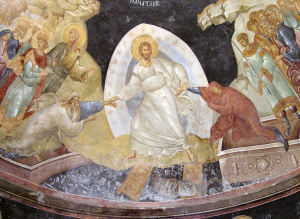This is the third of the series which started with Jesus was not a Jew – according to the Gospels (1) and continued with Jesus was not a Jew – according to the Gospels (2). Again, I am not at all trying to make an anti-Semitic point, as should be clear in what follows here.
 In parts 1 and 2 of this series I have shown that in the four Gospels the Greek word Ioudaios, generally translated “Jew”, is in fact used mainly of Judeans, inhabitants of the southern part of the land of Israel around Jerusalem. It is only when the word is used by Gentiles and Samaritans, or in conversation with them, that it has the wider meaning of “Israelite”.
In parts 1 and 2 of this series I have shown that in the four Gospels the Greek word Ioudaios, generally translated “Jew”, is in fact used mainly of Judeans, inhabitants of the southern part of the land of Israel around Jerusalem. It is only when the word is used by Gentiles and Samaritans, or in conversation with them, that it has the wider meaning of “Israelite”.
Before making some concluding observations, I want to look briefly at how this word is used in the rest of the New Testament.
In the Gospels the focus of the story is on the land of Israel, but in Acts it is suddenly opened up to include the whole world, or at least those parts where Israelites live. So immediately we see the word Ioudaios used, in 2:5,11,14, as it would have been by Greek speakers right across that world, as a synonym for “Israelite”. Oddly enough, this does not last. In 2:14 Peter calls his audience Ioudaioi, but by verse 22 the same people have become Israelitai, as also in 3:12; in 5:35 Gamaliel uses the same word, as do Paul in 13:16 and some Asian Jews in 21:28. Meanwhile Ioudaios is not used again in Acts until the action moves into the Gentile world in chapter 9. From then on the word is very common, and mostly used as Gentiles used it, of all Israelites.
The word Ioudaios is not common in the letters of Paul, but is again used mainly in the Gentile sense, indeed often in contrast with “Gentile” or “Greek”. A probable exception here is 1 Thessalonians 2:14, recently discussed by Daniel Kirk (no relation), where “Judean” fits the context better.
Ioudaios is not found in any of the other New Testament letters. It occurs twice in Revelation (2:9, 3:9), in both cases of enigmatic groups of people who claim to be Jews but, according to the author, are not; these are most likely Diaspora Israelites who were considered religiously apostate.
So, it seems to me, in translation we need two different renderings of Ioudaios, “Judean” for most of the Gospel references but excluding the ones on the lips of Gentiles and Samaritans, and “Jew” for almost all occurrences outside the Gospels.
A clear consequence of this choice of renderings, but by no means the motivation for it, is that it removes any biblical justification for blaming the Jewish people as a whole for the death of Jesus. If anyone is to be blamed, it is a small group of Judean Israelites, stirred up against Jesus by their leaders, and the Roman authorities under the weak Pilate.
Another clear consequence is that the Jesus of the Gospels was not considered to be a Ioudaios, at least by his fellow Israelites. This explains why, especially in John, he is often portrayed as being opposed to the Ioudaioi. But what may have been a secret to Jesus’ contemporaries is revealed in Matthew and Luke, and is perhaps implied by Mark’s use of the title “Son of David” (10:47,48, 12:35) and by John’s reference to the Messiah being from Bethlehem (7:42). This mystery is that Jesus was in fact a Judean, born in Bethlehem in Judea, a member of the tribe of Judah, and indeed a descendant of King David and of the whole royal line of Judah (Matthew 1:6-11). The New Testament record seems to imply that he was the rightful heir of the Davidic line, the true king of the Ioudaioi in both senses. And, as he told the Samaritan woman who called him a Ioudaios (John 4:9,22), in both senses “salvation is from the Ioudaioi” because it came through him.
So perhaps we should conclude that Jesus was not a Jew among others, he was the one true Jew, the forefather of a new Israel constituted not by physical descent but by faith in him. This was never intended to replace the old Israel, but it was intended to broaden that family to include Gentiles. But this is a controversial issue which I do not want to get into here.
So, as I conclude this series, have I rejected the claim in its title, “Jesus was not a Jew”? No, because I added “according to the Gospels”, and within those narratives Jesus is not one of the Judean people referred to as Ioudaioi. But within the wider narrative of the New Testament we recognise that Jesus is in fact a Jew par excellence, fulfilling in himself all the requirements and prophecies of the Old Testament as well as all the promises of the New.
This Man, who died for our sins, and rose again from the dead to show that he is more than just a man, is the great King we should follow, not only the King of the Ioudaioi but also the one which we Gentiles, grafted into the true Israel, acknowledge and serve as King.


.gif)





